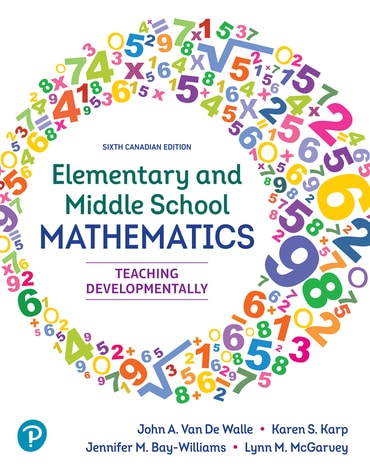
Elementary and Middle School Mathematics, Canadian Edition, 6th edition
Published by Pearson Canada (February 19, 2021) © 2022
- John A. Van de Walle |
- Karen S. Karp |
- Jennifer M. Bay-Williams |
- Lynn M. McGarvey |
Switch content of the page by the Role togglethe content would be changed according to the role
Title overview
For courses in teaching math methods (preK-8).
Guide teachers to help all PreK to 8th grade learners make sense of math
Elementary and Middle School Mathematics illustrates how children in PreK to 8th grade learn math, and then supplies concrete, effective methods of teaching math using problem-based activities. Examples of real student work, common challenges, and hundreds of classroom-ready hands-on tasks help readers visualize developmentally appropriate mathematics instruction and assessment that supports and challenges all learners.
Hallmark features of this title
- Big Ideas. Much of the research and literature espousing a student-centered approach suggests that teachers plan their instruction around big ideas rather than isolated skills or concepts. At the beginning of each chapter in Part II, you will find a list of the big mathematical ideas associated with the chapter. Teachers find these lists helpful to quickly envision the mathematics they are to teach.
- Mathematics Curriculum Connections. These figures at the beginning of each content chapter highlight the key ideas in the topic and the approximately grade level they appear in curriculum across Canada.
- Adaptations for Students with Difficulties and English Learners. Chapter 6 provides some background and strategies for how to support diverse learners, but many adaptations are specific to an activity or task. Therefore, Part II chapters offer differentiation strategies within activities (look for the icon) that can meet the needs of students with difficulties and English learners.
The 6th edition of Van de Walle will retire on June 1, 2026. Please speak to your rep about updating your course to the new 7th edition.
New and updated features of this title
- Learner Outcomes. Each chapter now begins with a set of learner outcomes. The outcomes are intended to provide a summary of the organization and content of each chapter, as well as the knowledge, skills, and expectations readers should attend to in the course of completing the chapter readings, activities and reflections.
- Canadian Curriculum Update. Provincial governments tend to revise or update their mathematics curriculum every five to ten years. Since the last edition of this textbook, only the Ontario mathematics curriculum has been revised. In the summer of 2020, Ontario Ministry of Education revealed a new mathematics curriculum for grades 1 to 8. Similar to British Columbia, the Ontario curriculum now includes financial literacy as a topic. It also includes new expectations in mathematical modelling and coding.
- Infusion of Technology. You may notice that Chapter 7 Tools for Learning Mathematics from the previous edition is gone. Readers and reviewers have commented that this chapter is no longer needed, in part be-cause discussing tools and technology is more helpful in context and when applied to specific tasks and problems.
Table of contents
- Teaching Mathematics in the 21st Century
- Exploring What It Means to Know and Do Mathematics
- Teaching through Problem Solving
- Planning in the Problem-Based Classroom
- Creating Assessments for Learning
- Teaching Mathematics Equitably to All Students
- Developing Early Number Concepts and Number Sense
- Developing Meanings for the Operations
- Developing Basic Fact Fluency
- Developing Whole-Number Place-Value Concepts
- Developing Strategies for Addition and Subtraction Computation
- Developing Strategies for Multiplication and Division Computation
- Algebraic Thinking, Equations, and Functions
- Developing Fraction Concepts
- Developing Fraction Operations
- Developing Decimal and Percent Concepts and Decimal Computation
- Ratios, Proportions, and Proportional Reasoning
- Developing Measurement Concepts
- Developing Geometric Thinking and Geometric Concepts
- Developing Concepts of Data and Statistics
- Exploring Concepts of Probability
- Developing Concepts of Exponents, Integers, and Real Numbers
